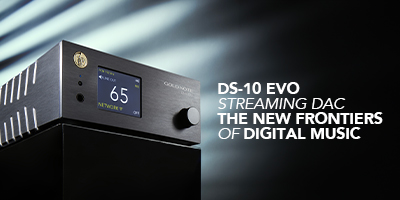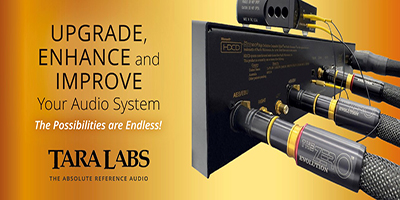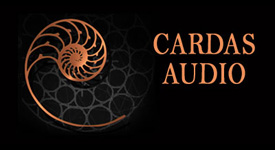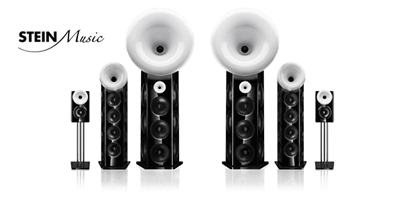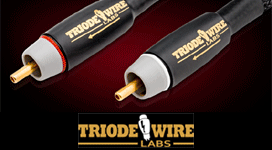Audio Note (UK) M8 RIAA Phono Preamplifier
When lifting the M8 RIAA out of its shipping carton, you'll want to be careful to protect your back, as it is quite heavy for a phono preamplifier at 37.5 pounds.
Let's do a quick "walk around" of the M8 phono preamplifier.
I really love the understated, elegant appearance of the M8 RIAA phono preamplifier. This M8 RIAA is fitted with the black front panel, but it is also available with a brushed aluminum front panel.
Above: "Level Five" M8 RIAA phono preamplifier.
On top of the chassis, you can see ventilation slots that give the hot-running vacuum tubes plenty of airflow. I recommend you give the M8 RIAA plenty of ventilation room so that airflow is not restricted. I placed the M8 RIAA on an Acoustic Revive air-isolation platform in the open to make sure it had plenty of ventilation.
On the front panel, you can see the Audio Note (UK) badging that indicates this is the M8 RIAA, and beneath that is a small red indicator light that illuminates when the M8 RIAA is powered up.
Above: M8 RIAA phono preamplifier rear panel.
On the back panel, from left to right, are the mains switch / IEC plug for the power cord / fuses, selector switch for balanced or single-ended operation, two pairs of RCA outputs for single-ended operation, a pair of RCA phono inputs, a pair of XLR balanced outputs, and the ground connection.
The M8 RIAA phono preamplifier fulfills all Audio Note (UK) Level 5 criteria:
- Pure Class A operation.
- Zero negative feedback.
- Single Ended circuit topology.
- Valve rectification.
- Level 5 materials and component quality.
The M8 RIAA technical specifications:
- Input Impedance: 47 KOhms
- Input Sensitivity: 126 mV for 1 V output
- Output Impedance: <10 Ohms
- Weight: 16 Kg
- Dimensions: 140 mm (h) x 440 mm (w) x 410 mm (d)
- Mains Input: AC 100-120 V / 220-240 V 50/60 Hz
You can read the user manual for the M8 RIAA phono preamplifier HERE.
Now let's take a tour inside of the M8 RIAA.
Above: Tomei 211 SET integrated amp (left) and M3 RIAA phono pre (right).
The M3 RIAA phono stage (above) is the first step of the M3 to M8 preamplifier family, all of which share the same circuit topology across the range: M3 (Level Three), M5, M6 (Level Four), and M8 (Level Five), with parts quality upgraded level by level within the range to give more refined and higher levels of performance.
Above: M6 RIAA (left) and M8 RIAA (right) front view.
I still have the “Level Four” M6 RIAA phono preamplifier here to serve as a basis of comparison for the “Level Five” M8 phono preamplifier for this article (below).
Above: "Level Four" M6 RIAA plus AN-S4/L SUT (left) and "Level Five" M8 RIAA plus AN-S8/L SUT (right).
Both the M6 RIAA and the M8 RIAA share the same circuit, with pure Class A operation, zero negative feedback, single-ended circuit topology, and valve rectification, but the M8 RIAA has upgraded materials and component quality in its circuit.
In the diagram above, you can see the valve complement for the M3, M5, M6, and M8 family of phono preamplifiers. If you look at the M6 & M8 columns, you can see that the valve complement for the M6 & M8 RIAA versions differ only in V2, where the M6 utilizes a 7044 in V2, and the M8 a 6463 in V2.
In perusing Audio Note (UK)’s descriptions of the M6 and M8 RIAAs - I put the differences in bold font - we read the following:
"At the heart of the M6 RIAA is an exceptionally fine moving magnet phono stage which uses three 5670 valves. This is followed by a 7044-equipped line stage, and both sections are powered by their own dedicated 6X5 valve rectified power supply based on the M10 Galahad PSU. These power supplies also incorporate an ECL82 for voltage regulation and a 5651 as a voltage stabilizer. Audio Note (UK) copper wiring, Audio Note (UK) one-watt tantalum resistors, our own custom electrolytic capacitors, and Audio Note (UK) copper foil signal capacitors are used throughout the circuit, along with in-house-designed and manufactured, custom Audio Note (UK) output transformers which feature UHiB double c-cores, copper windings for the primaries, and silver windings for the secondaries. The M6 RIAA also has a correctly designed and implemented balanced output circuit.”
"At the heart of the M8 RIAA is an exceptionally fine moving magnet phono stage which uses three 5670 valves. This is followed by a 6463-equipped line stage, and both sections are powered by their own dedicated 6X5 valve rectified power supply based on the M10 Galahad PSU. These power supplies also incorporate an ECL82 for voltage regulation and a 5651 as a voltage stabilizer. Audio Note (UK) silver wiring, Audio Note (UK) two-watt tantalum resistors, custom Audio Note (UK) electrolytic capacitors, and Audio Note (UK) silver foil signal capacitors are used throughout the circuit, along with in-house-designed and manufactured, custom Audio Note (UK) output transformers which feature HiB 50% nickel double C-cores, silver windings for both the primaries and for the secondaries. The M8 RIAA also has a correctly designed and implemented balanced output circuit.”
So the circuit upgrades when going from the M6 to M8 RIAA are going from a V2 of 7044 to 6463, from copper to silver wiring, from one watt tantalum resistors to two-watt tantalum resistors, from copper foil signal capacitors to silver foil signal capacitors, and from output transformers with UHiB double C-cores / copper wound primaries / silver wound secondaries to output transformers with HiB 50% nickel double C-cores and silver wound primaries & secondaries.
From the outside, the M6 RIAA and M8 RIAA look identical except for their front panel names.
Now let's take a look inside.
Above: M6 RIAA (left), M8 RIAA (right).
You can see that the layout of the circuit components are the same between the M6 & M8. Some of the circuit boards are a different color.
Below is the power supply side of the M6 RIAA's chassis.
Above: Power supplies side of the M6 RIAA.
Below is the power supply side of the M8's chassis.
Above: Power supplies side of the M8 RIAA.
Note the copper wiring on the M6 power transformers below.
Above: M6 RIAA with copper wiring.
Note the silver wiring on the M8 power transformers (below).
Above: M8 RIAA with silver wiring.
In the power supply side of the chassis for the M6 (below), note the 10,000uF Kaisei electrolytic capacitor on the left, and the three smaller Kaisei electrolytic caps on the circuit board. These capacitors are custom-made for Audio Note (UK) by the "engineering team at Rubycon (of Black Gate fame).” They are based on the same materials with the only difference being the paper used is not impregnated with graphite particles. Otherwise, the Kaisei capacitors use the same special electrolyte.
Note also the one-watt tantalum resistors on the circuit board. "Tantalum, the Tone King ... We have gone to great lengths to ensure a continuing supply of these wonderful, tone-full components, even to the extent of convincing the manufacturer to continue production, purely to supply our requirements.”
Above: M6 power supply side.
In the power supply side of the M8's chassis (below), note the four 2200uF Kaisei electrolytic capacitors on the left, and the three smaller Kaisei electrolytic capacitors on the circuit board.
Notice also the "plump" two-watt tantalum "Tone-King" resistors on the circuit board, and the silver wiring to the circuit board.
Above: M8 power supply side.
The phono and line stage of the M6 RIAA are powered by their own dedicated 6X5 valve rectified power supplies based on the M10 Galahad power supply designed by Andy Grove (below). There is more information on the Galahad power supply HERE.
The M6 power supplies use 2 x NOS Phillips 6X5G rectifiers in V3 and V9, 2 x NOS RCA ECL82/6BM8 valves in V4 and V10 for voltage regulation, and 2 x NOS Raytheon JAN 5651WA valves in V5 and V11 as voltage stabilizers.
The M6's wiring is copper, the resistors are one-watt tantalum, and there are custom Kaisei electrolytic capacitors (think Black Gate).
Above: M6 power supplies.
As with the M6, the phono and line stage of the M8 RIAA are powered by their own dedicated 6X5 valve rectified power supplies based on the M10 Galahad power supply designed by Andy Grove (below).
The M8 power supplies use 2 x NOS Phillips 6X5G rectifiers in V3 and V9, 2 x NOS Siemens ECL82/6BM8 valves (made in Germany) in V4 and V10 for voltage regulation, and 2 x NOS Raytheon JAN 5651WA valves in V5 and V11 as voltage stabilizers.
The M8's wiring is silver, the resistors are two-watt tantalum, and there are custom Kaisei electrolytic capacitors (e.g. think Black Gate).
Above: M8 power supplies.
Please click on the link below to go to the next page.

